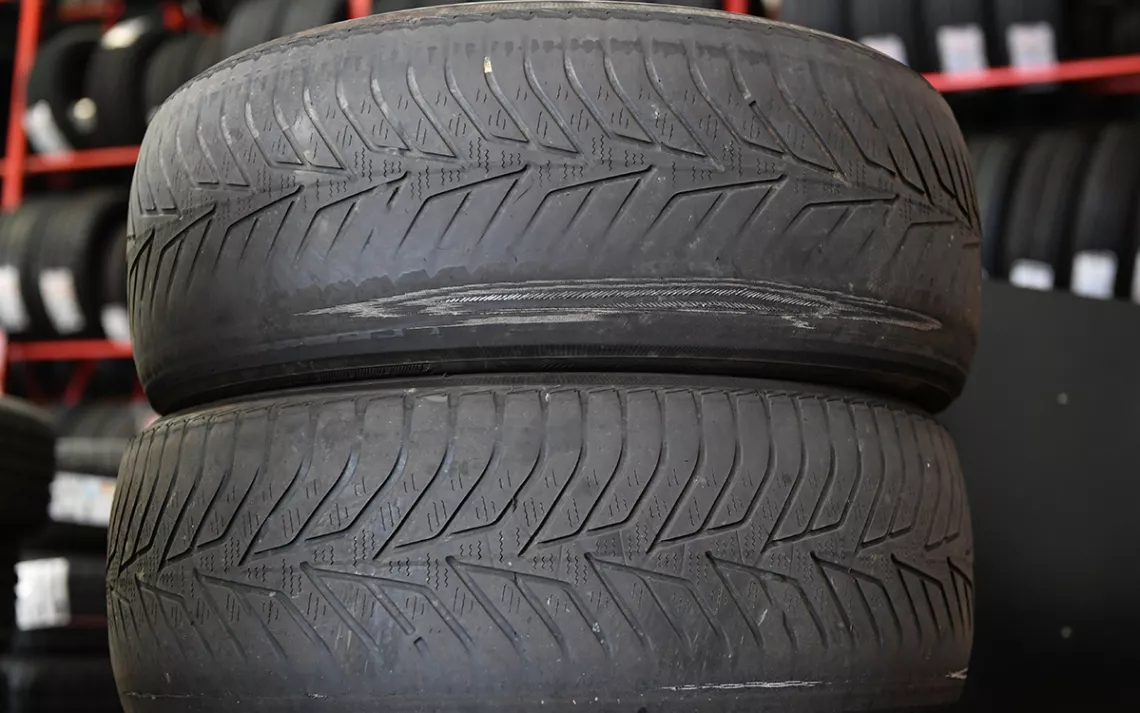More Cars on the Road, Clean or Not, Means More Microplastics
Scientists are puzzling over how to tackle the problem as the transition to electric vehicles gets underway

Photo by Ben Birchall/PA Wire URN:53887992/Press Association via AP Images
When Governor Gavin Newsom announced that all new car sales in California would be zero-emission vehicles by 2035, many activists celebrated the move. They cited its importance to cleaning up the environment, protecting public health, and taking action on climate. But there was a word few people mentioned in response to the news: microplastics.
One of the potential unintended consequences of the transition to electric vehicles could be more microplastics. When rubber meets road, tires shed small synthetic polymers less than five millimeters in diameter. Electric vehicles, often presented as the best ways to reduce carbon emissions and the key to addressing climate change, shed more particles than traditional internal combustion engine vehicles.
“We ended up estimating that stormwater was discharging about 7 trillion [microplastics] into the [San Francisco] Bay annually,” said Rebecca Sutton, a senior researcher at the San Francisco Estuary Institute (SFEI). Half of those particles come from tires. “That might be just the tip of the iceberg.” These tire particles are already in the air we breathe as well as the San Francisco Bay and the groundwater that empties into it.
Once in the environment, tire particles threaten human and wildlife health through countless pathways. “Tires include antioxidants which are purposefully added to keep the tire from breaking down,” said Ezra Miller, another scientist at the SFEI with expertise in microplastics and fish contamination. When one of these chemical compounds, the antioxidant 6PPD, reacts with ozone in the air, it creates 6PPD-quinone, a water-soluble compound that kills coho salmon, even at low levels, according to research published by a group of Washington scientists in 2021.
Coho salmon have not inhabited the San Francisco Bay in decades. But their close relative steelhead trout do, and 6PPD-quinone is harmful to their health as well. Scientists at the National Oceanic and Atmospheric Administration found that when steelhead trout were exposed to urban stormwater containing 6PPD-quinone, they experienced the same suite of symptoms observed in the coho salmon: fin splaying, gaping, and disorientation. Within two days, up to 42 percent of the exposed steelhead population died.
Even if the fish do not die on exposure, the scientists speculate that the chemical might have sub-lethal effects that could compromise the fish’s ability to reproduce or evade predators. Other chemicals in tires also pose risks to aquatic life, and SFEI researchers have identified some of them (phthalates and bisphenols, for example) in the bay and nearby watersheds. But the effects of these tire additives in the environment are largely unknown given that chemical formulations in tires are often proprietary, making them difficult to study.
Tire particles are especially harmful because of their small size. “People think they’re breaking down, but the way they’re breaking down is into smaller particles,” said Miller. The smaller the particle, the more these contaminants leak into nearby watersheds, he explained.
Many tire particles shed while driving are smaller than 10 microns in diameter—about 10 times smaller than a grain of powdered sugar. “Those particles can get very deep into our lungs, and we have trouble excreting them again,” said Miller. We often think that air quality and human health are worse close to highways due to car exhaust, but tire particles play a role too.
Tire microplastics are already a huge concern in the bay. In September 2022, California became the first state to test drinking water for microplastics, evidence that monitoring microplastics is a statewide priority. However, transitioning to electric vehicles will increase the number of particles shed by tires and released into the environment. Despite the statewide focus on microplastics, tire wear pollution is entirely unregulated.
Emissions Analytics, an independent global organization specializing in testing and measurement of real-world emissions, found that pollution from tire wear is 1,850 times worse than exhaust emissions, by mass. Beyond that, the Emissions Analytics team found that the extra weight of an electric vehicle battery can dramatically increase the shedding of tire wear particles, creating additional tire emissions that are 400 times greater than exhaust emissions.
Engineers design electric vehicle tires to be more durable, changing the tire tread and composition and even widening the tires to withstand the increased load, said Günter Leister, founder of the German consulting group Tire Wheel Mobility Solutions. But widening tires creates an additional problem: “Wider tires lead to more tire wear,” Leister said. “Electric vehicles have more rubber to be worn.”
The problem of vehicle tire shedding is tricky to address. “There is no engineering solution,” said Saied Taheri, professor at Virginia Tech. Cars need friction to move, and tire shedding occurs whenever there is friction.
Sometimes car manufacturers add silica to car tires to decrease rolling resistance, the force a rolling object encounters when it meets another surface, and prolong the lifespan of tires, Taheri said. But silica, a known carcinogen, poses additional environmental and health concerns.
Moreover, manufacturers cannot make tires biodegradable. UC Berkeley chemistry professor Ting Xu and her fellow researchers used enzymes to break down synthetic polymers as an alternative to single-use plastic. But when people’s lives are at stake, as they are in vehicles, you “can’t have a failure,” Xu said. Tires must hold up in a wide range of environmental and weather conditions to be effective. Compostable tires would present a major safety hazard.
The remaining potential solutions include driving less, transitioning to longer-life tires, and even installing debris collection systems on vehicles to capture particles at the source of emission before they disperse. These strategies will be critical moving forward because it is nearly impossible to remove tire particles that are already in the bay, and the concentration of tire particles will only increase.
“We don’t always know exactly what level [of tire particles] may be safe or unsafe for different animals or plants,” Sutton said, “but because we know they persist and build up, at some point they are going to exceed thresholds for safety.”
 The Magazine of The Sierra Club
The Magazine of The Sierra Club



